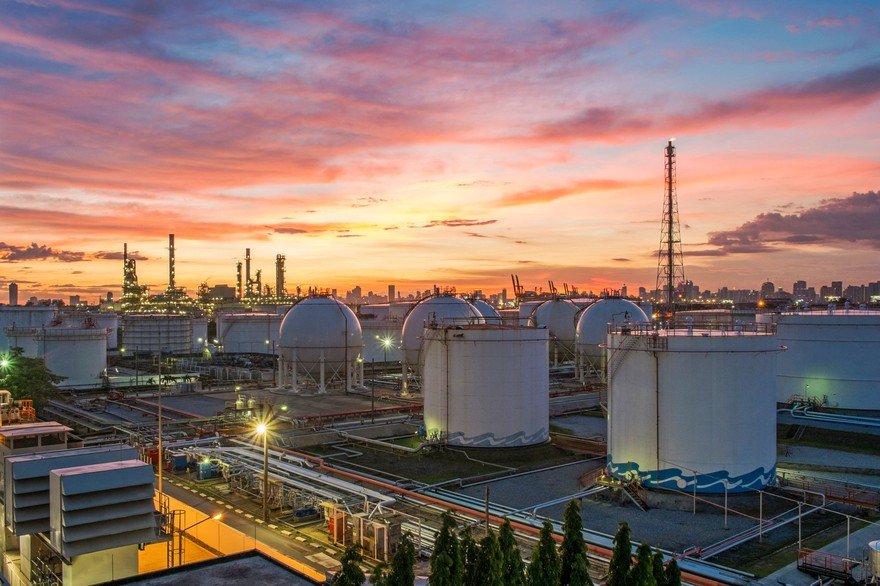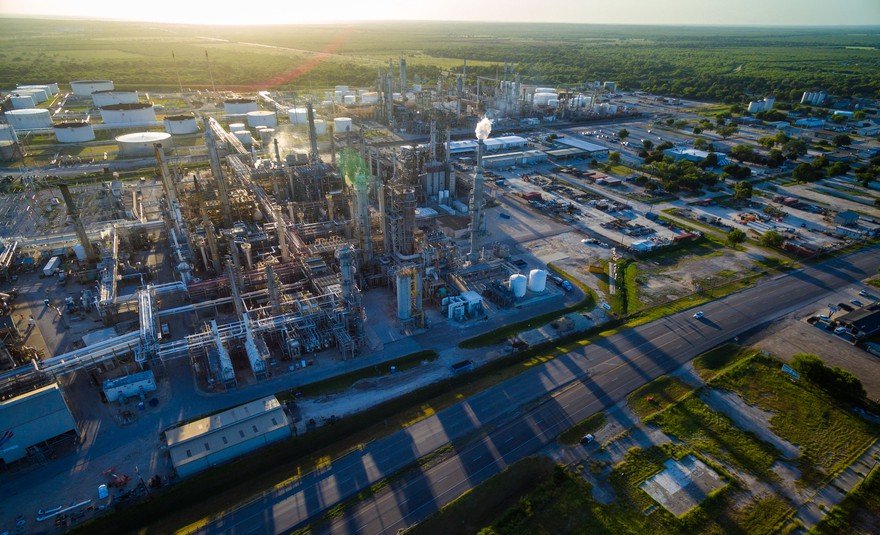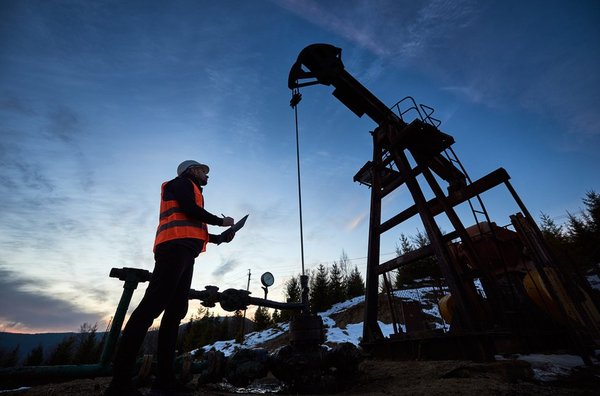Refineries take raw crude oil and refine it into usable fuels and other refined petroleum products. That puts refining companies in the last link of the oil industry's three-part value chain that works together to transform raw production into usable end products:
- The upstream oil and gas segment produces hydrocarbons -- oil, natural gas, and natural gas liquids (NGLs) -- by drilling wells into underground reservoirs.
- The midstream segment then transports, stores, and processes these hydrocarbons.
- Finally, oil and gas flow into downstream facilities such as refineries and petrochemical plants, which transform them into usable products such as fuels and plastics.
Because refiners consume oil in their plants, refining companies tend to benefit when oil prices fall. That often makes a refining stock an excellent complimentary holding for investors who also have shares of an upstream oil producer in their portfolios. This investment pairing will help mute some of the effects of oil price volatility. It's one of the many factors that make refining stocks appealing to investors.

How is oil refined?
Oil refiners play an essential role in the oil industry. These industrial complexes process raw crude oil into a variety of higher-value refined petroleum products. These products include liquid fuels (gasoline, diesel, kerosene, jet fuel, heating oil, and fuel oil) and other products (asphalt, tar, paraffin wax, and lubricating oil).
Oil refineries process crude into these various products using a three-step process:
- The separation process pipes crude oil through hot furnaces that discharge the liquids and vapors into distillation units. The oil then separates into fractions according to their boiling points.
- The conversion process, also known as cracking, uses heat, pressure, and a catalyst to crack heavy hydrocarbon molecules into lighter ones.
- In the treatment process, a refinery will combine different hydrocarbon streams to create a finished refined product (i.e., gasoline, diesel, etc.). Those refined products then go into storage until they're transported to end users like gas stations.
Key refining industry terms
Investors who are new to the refining industry need to familiarize themselves with three key terms used in the sector:
- The crack spread is an oil industry term that refers to the difference in price between where a refinery buys raw crude oil and sells the petroleum products it makes from this oil. The spread is the profit margin made from "cracking" unrefined oil into higher-valued refined products.
- The Nelson Complexity Index (NCI) rates refineries on their ability to produce lighter, more refined and valuable products such as jet fuel and low-sulfur diesel. The scale goes from 1 to 20, with a higher number implying a more complex refinery. While high-NCI refineries cost more to build, operate, and maintain, they produce greater volumes of higher-valued refined products.
- The utilization rate is the percentage of a refinery's capacity that it used in a particular period. For example, if a refinery has 500,000 barrels per day (BPD) of throughput capacity but only processed an average of 450,000 barrels for the year, its utilization rate was 90%. The higher the utilization rate, the more efficient a refinery was during the period. Higher utilization enables a refinery to produce a larger quantity of refined products. That allows it both to make more money on the additional volumes and to spread its costs out over more barrels.
How oil refiners make money
Oil refineries typically buy raw crude oil from producers and have it shipped to their facilities via pipeline, truck, or rail. They process this oil into the following refined products:
- Gasoline
- Diesel
- Jet fuel
- Lubricants
- Waxes
- Asphalt
- Naphtha
- Kerosene
Each 42-gallon barrel of crude oil typically produces about 45 gallons of petroleum products because of refinery processing gains. The largest finished product is gasoline, at 19 gallons from each barrel of oil. Refiners then sell these refined products to end users, including at their own branded gas stations.
Refineries make money by way of the crack spread; as noted earlier, it's the difference between how much they pay to buy raw crude oil and how much they make when selling the finished refined petroleum products. This spread fluctuates with the price of oil and with demand for refined products.
When oil prices are high, the crack spread tends to shrink until market prices for refined products increase to reflect the rise in crude prices. Meanwhile, if refined product consumption is low, refining margins tend to contract, which means refiners make less money. Oil refineries, on the other hand, can make a lot of money when the demand for refined products is high while oil prices are low. That market environment causes the spread between where they buy oil and sell the associated refined petroleum products to widen considerably.

Types of refining companies
Oil refining operations fall into two categories: Either they're integrated into large oil companies or they operate independently.
Many large oil companies own oil refineries so that they can process a portion of their production into higher-valued refined products. These entities, known as integrated oil companies, operate refineries for two reasons. First, it enables them to maximize their per-barrel earnings. They can make money not only on producing oil but also on the crack spread as they refine their crude into higher-valued petroleum products. The other benefit of this integration is that oil refining acts as a natural hedge against falling oil prices, since their refineries benefit from lower oil prices. That helps reduce their earnings volatility.
Independent oil refiners, meanwhile, focus mainly on operating refineries. Some independent refining companies will only operate refining complexes. Others, meanwhile, have some vertical integration but don't go all the way upstream. For example, many will own midstream assets like oil and refined products pipelines, as well as other downstream assets such as petrochemical plants, ethanol production facilities, lubricant manufacturing plants, and retail gas stations.
Integrated oil companies typically make most of their money producing oil, using their refining assets to maximize their per-barrel profit as well as to help mute some of the volatility of oil prices. Independent refining companies, on the other hand, tend to make the bulk of their profits by refining oil into higher-valued petroleum products. Given that difference, investors who are interested in making money from the refining industry should focus on independent refining companies.
One other thing that sets the refining industry apart from the upstream oil and gas production sector is that it's less capital intensive, which means that refiners don't need to invest as much money to maintain their operations. Many large independent refiners, for example, aim to reinvest 40% to 60% of their cash flow in capital projects, with only about 40% of that spending typically on maintenance activities and the rest on growth-focused initiatives. That enables them to return 40% to 60% of their free cash flow to investors via dividends and share repurchases. Oil companies, on the other hand, need to reinvest a larger portion of their cash flow into sustaining their production by drilling new wells, especially when oil prices are lower. That leaves them with less money not only for drilling new wells that grow production but also for shareholder-friendly activities like dividends and buybacks.
Refining stocks can help balance your portfolio
Oil refineries take raw crude oil and transform it into higher-value products, making money on the difference between the prices at which they buy oil and sell refined products. This process enables these companies to generate lots of cash, the bulk of which they use to either grow their operations or reward shareholders through dividends and buybacks.
These characteristics make refining stocks appealing options for investors. That's because they offer exposure to the oil market without the extreme downside that can come from lower oil prices, since refiners tend to benefit when crude declines. This factor should make refining stocks particularly appealing to investors who own shares of an oil-producing company. They might want to consider pairing that investment with a refining stock, since it should help mute some of the impacts of oil price volatility.
Aside from that, refining companies tend to be excellent dividend stocks. Not only do they tend to pay above-average dividends, but they also increase their payouts each year. That combination makes refining stocks ideal options for income-seeking investors to consider.












